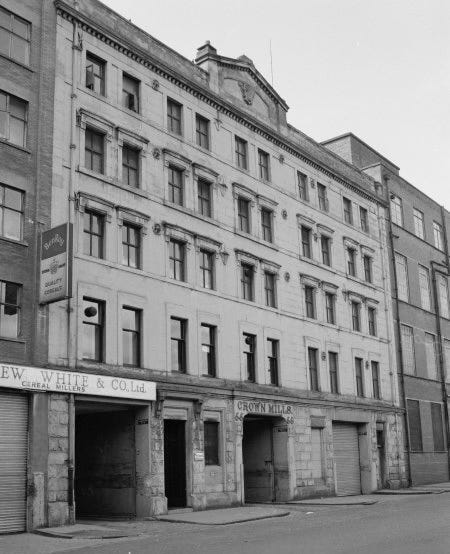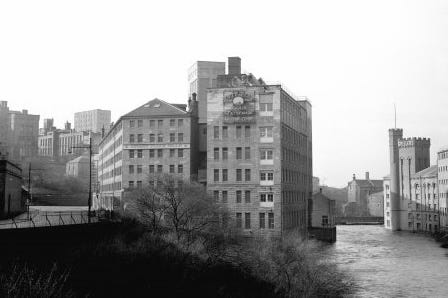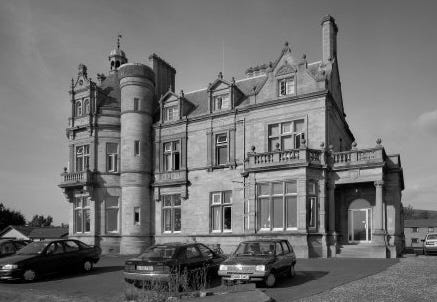In my article ‘The Ure family and the Stockwell Street tenement’, we left the family of family of John Ure, the successful Glasgow baker, having possibly constructed (or not) a tenement in Stockwell Street, designed by the partnership of John Baird and Alexander Thomson. Even if built, it seems likely that it would have been demolished in the widespread reconstruction of the area by 1895, as shown in John Bartholomew’s map below, to accommodate railway access to what would become St Enoch station expansion.
If it remained even then, it might well have come down later, as East Howard Street was widened, renamed Howard Street, and extended across Stockwell Street to meet the southern curve of the expanded number of railway lines, as seen in this later Ordnance Survey map.
Beyond Stockwell
The Ure family were not finished with business expansion or developing what must have been a range of property interests. In 1845, they sought a new tenant for a shop, dwelling house and bakehouse in Parkhead; there must have been some family or ownership connection since the property was advertised again three years later1.
There was more property: in 1848, John Ure, a baker in Glasgow, leased Moffat paper mill to John Drummond Benton, a Glasgow merchant2. In 1858, at Glasgow’s Dean of Guild Court,
Mr John Ure, baker in Glasgow, and others, applied for leave to erect a tenement of houses on Pollokshaws Road - the elevation of which is to be of a highly ornamental character. The case was delayed at the request of the conterminous proprietors3.
Six years later, in 1864, an application came from
Mr John Ure and others, trustees of the late Mr John Ure, baker, Glasgow, to make certain alterations, conform to plans, on erections on steading of ground in Eglinton Street4
and the following year,
Thomas Ure, baker, Glasgow, to erect dwelling houses, shops, and bakehouse on ground north side of William Street, Cowcaddens5.
For none of these do we currently have the name of the architects or the precise location. A decade later, John Ure, baker, and Robert Ure, portioner, were sued by George Robertson, a spirit dealer of New City Road, over an alleged breach of contract relating to the leasing of a property at 127 Stockwell Street. Robertson lost6.
Which one’s Ures?
In all these dealings, the challenge is to try and establish which members of the Ure family, with their multiplicity of similar names, we are talking about.
Just to be more confusing, for some years, two companies named ‘John Ure & Sons’ were based in Glasgow: the non-bakery one was a firm of cotton merchants, one-time traders with partners in Liverpool, Kingston in Jamaica and New Orleans7. This firm was headed by John Ure (ca 1760-1849, sometimes suffixed as ‘of Croy’). He was described at his death as ‘one of the oldest Radical reformers of Glasgow’, a one-time Glasgow councillor elected to the first Council after the 1832 Reform Act, a JP, and late in life honorary Baillie of Provan. His politics may have been behind his 1820 break with his partners’ slave-based trading. His family appears to have been responsible for developing Ure Place at the northern end of Montrose Street, which was probably developed from a lodging house operated by John Ure at 52 Montrose Street in the early 19th century. Ure Place was demolished in 1905 and replaced by the Glasgow Maternity Hospital. The family of this John Ure came originally from Stirlingshire, so were likely distant cousins of the Ure bakers8.
As to the bakers, by 1818, the Glasgow Directory listed various of them:
Alexander Ure, pastry-baker, 12 Hutcheson-street
George Ure, baker, 64, High-street
John Ure, baker, 60 Stockwell
John Ure, junior, baker, 80, Bridgegate
David Ure, a baker in Grahamston.
The Ure family of Glasgow bakers appear largely to descend from George Ure (1721- ca 1763), youngest son of James Ure and Eupham ('Euphemia') Buckie, who married, either in Larbert or Dunipace, Stirlingshire, around 1710. The two parishes were served by one minister for many years well into the 19th century, so references to ‘Larbert’ and ‘Dunipace’ may simply reflect in which of the two churches events were registered rather than any change of location.
They had six known sons, of whom two at least appear to have survived to adulthood and marriage. The elder brother known to have done so, Alexander (b. 1714), seems to have stayed in Larbert, where all his children were born: many of his sons worked in iron foundries or as clerks in various trades. It is possible that Alexander’s son John (b.1749) was a baker in Glasgow at least by 1770. Otherwise, it was Alexander’s brother George (1721-ca 1763), who seems to have been the first member of the family to enter the trade, achieved by marrying Janet Weir, whose father was a Glasgow baker. The marriage allowed him to be enrolled in the Incorporation of Bakers of Glasgow in 1750.
George’s two sons both became bakers: the elder son, James (1750-1811), was enrolled aged 13, following the death of his father, presumably a well-meaning act by a sponsor to enable him to earn a living. Instead, he was removed from membership until he reached adulthood, and his sponsor rebuked. Although James’s re-enrolment is not shown in the Incorporation’s lists of members, he appears in the first 1799 Glasgow Directory as a baker at Bridgegate (afterwards identified as No. 105). After James died in 1811, his wife, Margaret Tod, continued the business for a few years more. Their eldest son, George (1784-1832), seems to have opened his own bakery at 64 High Street the year before his father’s death and continued to operate from there until the late 1820s when he moved to 36 Kent Street, where he died from ‘water on the chest’ in 1836.
George’s second son, John (1755-1820), was enrolled in the Incorporation in 1775 and was in business at 60 Stockwell (as it tended to be called) up to his death. He seems to have married twice, the first marriage producing a son, William, who predeceased him, leaving two daughters. In 1811, John married again, to a wife thirty years younger, who bore him three sons and two daughters. All three sons married and had children, but only the eldest son, John (1812-1880), went into the bakery business, working from 119 Stockwell Street. He may have sought to dispose of this or another bakery early on, advertising ‘A good business... in a respectable part of the town’9, but otherwise he stayed there until around 1870, when he moved with his family to Greenfaulds Villa in Cumbernauld. The second son, George (1818-1861), became a cotton dyer, while Robert (1820-1878) moved to South Australia as a farmer, where he married, had at least three children (one of whom died in infancy), then returned to Glasgow.
William Ure, George’s grandson, who died sometime before 1820, left two daughters; the younger married Robert Rowan, a cotton handloom weaver, but the elder, Jean (sometimes ‘Jane’), married a cousin, John Ure, Alexander’s grandson, the son of his youngest son, another Alexander. This is the John Ure who died at 7 Park Place in 1849, and whose trustees sought to build a Baird & Thomson tenement in Stockwell Street.
John Ure, Miller and Lord Provost
The 1818 marriage between John Ure and Jean Ure produced four sons and four daughters, with one son known to have died in infancy. The second surviving son, John (1824-1901), became the most well-known family member of his generation. Although trained as a baker, after his father’s death, he quickly moved from baking to flour milling. By 1854, he had been elected Deacon Convenor of the Incorporation of Bakers10, and elected again in 1857, the year he was elected a Town Councillor. Campaigning against a respected sitting candidate, the election generated wide local interest, with 461 out of 744 electors voting, more than twice that for the previous election. Press reports claimed him to be a teetotaller, something he then had to deny, leading one newspaper to report, ‘He may make a very good Councillor, although not an abstainer’11. He would later play various roles on the Council, with a sustained interest in improving sanitary conditions:
He secured the appointment of a medical officer of health, the organisation of the cleansing department, inquiry into the disposal of sewage and drainage of the city, and other measures of a like character.
The Ure family appeared to be involved in other bakery businesses: in 1852, they promoted an interest in a West Coast bakery, where a shop, house, and bakehouse were to let ‘at a thriving watering place... where a good business is done during summer, and a fair trade throughout winter’ and in 1855 advertised for a pastry baker in the north of Ireland12. By then, the family’s business had moved to 49 West Howard Street; in 1856, the Bridgegate bakehouse and shop were offered to let13.
Up to 1865, as flour millers, John Ure & Sons had their grain milled at the Clayslaps and Bunhouse mills in Partick, operated by the Incorporation of Bakers. In 1865, however, John Ure & Sons constructed the Crown Mills in Washington Street (below, around 1960).
In 1880, John Ure was elected Lord Provost, overseeing the foundation stone laying for the new City Chambers in 1883. However, he declined a second term of office and travelled round the world for much of the following year. On his return, he became deputy chairman of the Clyde Navigation Trust and, between 1889 and 1891, was both Lord Dean of Guild and chairman of the Merchants’ House. He declined a knighthood from Prime Minister Gladstone but, in 1896, accepted the degree of LL.D. from Glasgow University.
When the Bunhouse Mill in Partick burned down in 1886, the Incorporation of Bakers decided not to rebuild it since most bakers now purchased pre-ground flour. John Ure stepped in and took over the site, constructing Regent Mills (the right-hand portion of the block below, heightened by the Scottish Co-operative Wholesale Society sometime after 1905). Both this and the Crown Mills have since been demolished.
In 1870, architect William Leiper moved from Glasgow to Helensburgh. Either that year, if not earlier, John Ure commissioned Cairndhu (below), with interior decorations by Daniel Cottier. Ure lived there with his family until he died in 1901.
Three of John Ure’s sons also joined the milling business, but a fourth, Alexander (1855-1928), went into law, ending up as a King’s Council, MP for Linlithgowshire, and Baron Strathclyde of Sandyford. He also died at Cairndhu.
A neighbourly connection
Having commissioned one building from Baird and Thomson, whether or not it was ever built, John Ure’s eldest son ended up next door to another in Helensburgh: by 1891, John Gibb Ure (1851-1946) lived with his family at Rockbank14 at what was then No. 82 East Clyde Street, adjacent to Thomson’s first Grecian villa, West Rockbank (later Rockland, below, with a later conservatory), at No. 80 (the street has since been renumbered).
Thomson’s West Rockbank (with lodge), constructed around 1854, seems to have replaced Rockbank Villa, a ten-room marine villa set in three acres of ground in 184415, reduced to two acres five years later, presumably to allow more than one property to be built.
Glasgow Herald, 25 Feb 1848
Glasgow Herald, 21 Jul 1864
Glasgow Sentinel 14 Aug 1858
Glasgow Morning Journal, 12 Feb 1864
Glasgow Herald, 11 Aug 1865
North British Daily Mail, 6 Dec 1875
Glasgow Herald, 24 Nov 1820
Glasgow Chronicle, 5 Jul 1848
Glasgow Herald, 14 Aug 1846
Glasgow Herald, 2 Oct 1854
North British Daily Mail, 5 Nov 1856 and 6 Nov 1856
Glasgow Herald, 18 Oct 1852, 7 Jan 1855
Glasgow Herald, 7 Mar 1856
A later resident was Dr Osborne Henry Mavor, otherwise known as the playwright James Bridie
Glasgow Herald, 8 Apr 1844










And, completely irrelevantly, John Ure and his wife and daughter lived in the bottom flat (with separate street door!) and my parents in the top of the typical 4-storey (spacious, west end) tenemented terrace; when my mother was pregnant with me, they swapped (I've no idea of financial arrangements!) and the addresses changed between 19 and 17. Their daughter Mary, when barely a teenager would take me for walks in my pram, as WW2 continued. Some years later, Mary left home, became an actress, starred in Look back in Anger, and married its author, John Osborne.
No relation?